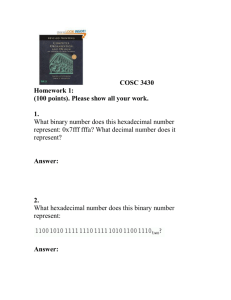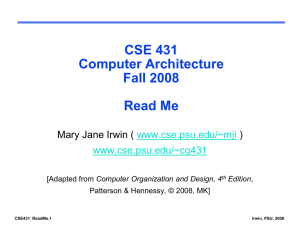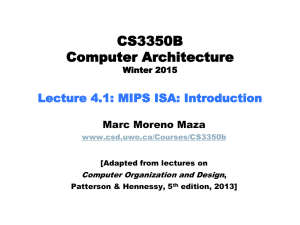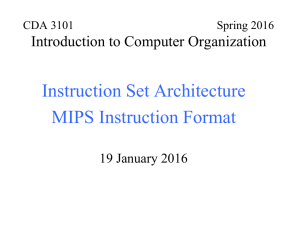CSE 431. Computer Architecture
advertisement
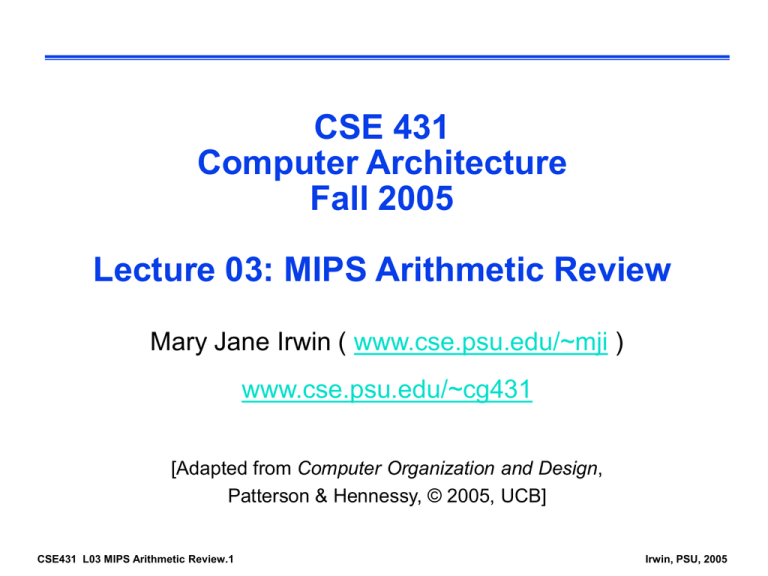
CSE 431 Computer Architecture Fall 2005 Lecture 03: MIPS Arithmetic Review Mary Jane Irwin ( www.cse.psu.edu/~mji ) www.cse.psu.edu/~cg431 [Adapted from Computer Organization and Design, Patterson & Hennessy, © 2005, UCB] CSE431 L03 MIPS Arithmetic Review.1 Irwin, PSU, 2005 Review: MIPS Organization Processor src1 addr 5 src2 addr 5 dst addr write data 5 Memory Register File 32 registers ($zero - $ra) 1…1100 src1 data 32 read/write addr src2 32 data 32 32 32 bits branch offset 32 Fetch PC = PC+4 Exec 32 Add PC 32 Add 4 read data 32 32 32 write data 32 Decode 230 words 32 32 ALU 32 32 4 0 5 1 6 2 32 bits 7 3 0…1100 0…1000 0…0100 0…0000 word address (binary) byte address (big Endian) CSE431 L03 MIPS Arithmetic Review.2 Irwin, PSU, 2005 Review: MIPS Addressing Modes 1. Operand: Register addressing op rs rt rd funct Register word operand 2. Operand: Base addressing op rs rt offset Memory word or byte operand base register 3. Operand: Immediate addressing op rs rt operand 4. Instruction: PC-relative addressing op rs rt offset Memory branch destination instruction Program Counter (PC) 5. Instruction: Pseudo-direct addressing op Memory jump address || jump destination instruction Program Counter (PC) CSE431 L03 MIPS Arithmetic Review.3 Irwin, PSU, 2005 Because ease of use is the purpose, this ratio of function to conceptual complexity is the ultimate test of system design. Neither function alone nor simplicity alone defines a good design. The Mythical Man-Month, Brooks, pg. 43 CSE431 L03 MIPS Arithmetic Review.4 Irwin, PSU, 2005 MIPS Number Representations 32-bit signed numbers (2’s complement): 0000 0000 0000 0000 0000 0000 0000 0000two = 0ten 0000 0000 0000 0000 0000 0000 0000 0001two = + 1ten ... 0111 0111 1000 1000 ... MSB 1111 1111 0000 0000 1111 1111 0000 0000 1111 1111 0000 0000 1111 1111 0000 0000 1111 1111 0000 0000 1111 1111 0000 0000 1110two 1111two 0000two 0001two = = = = + + – – maxint 2,147,483,646ten 2,147,483,647ten 2,147,483,648ten 2,147,483,647ten 1111 1111 1111 1111 1111 1111 1111 1110two = – 2ten 1111 1111 1111 1111 1111 1111 1111 1111two = – 1ten minint LSB Converting <32-bit values into 32-bit values copy the most significant bit (the sign bit) into the “empty” bits 0010 -> 0000 0010 1010 -> 1111 1010 sign extend CSE431 L03 MIPS Arithmetic Review.5 versus zero extend (lb vs. lbu) Irwin, PSU, 2005 MIPS Arithmetic Logic Unit (ALU) zero ovf Must support the Arithmetic/Logic operations of the ISA add, addi, addiu, addu 1 1 A 32 sub, subu, neg ALU mult, multu, div, divu sqrt result 32 B 32 and, andi, nor, or, ori, xor, xori 4 m (operation) beq, bne, slt, slti, sltiu, sltu With special handling for sign extend – addi, addiu andi, ori, xori, slti, sltiu zero extend – lbu, addiu, sltiu no overflow detected – addu, addiu, subu, multu, divu, sltiu, sltu CSE431 L03 MIPS Arithmetic Review.6 Irwin, PSU, 2005 Review: 2’s Complement Binary Representation -23 = Negate -(23 - 1) = 1011 and add a 1 1010 complement all the bits Note: negate and invert are different! CSE431 L03 MIPS Arithmetic Review.7 23 - 1 = 2’sc binary 1000 1001 1010 1011 1100 1101 1110 1111 0000 0001 0010 0011 0100 0101 0110 0111 decimal -8 -7 -6 -5 -4 -3 -2 -1 0 1 2 3 4 5 6 7 Irwin, PSU, 2005 Review: A Full Adder carry_in A B 1-bit Full Adder carry_out S A B carry_in carry_out S 0 0 0 0 0 0 0 1 0 1 0 1 0 0 1 0 1 1 1 0 1 0 0 0 1 1 0 1 1 0 1 1 0 1 0 1 1 1 1 1 S = A B carry_in (odd parity function) carry_out = A&B | A&carry_in | B&carry_in (majority function) How can we use it to build a 32-bit adder? How can we modify it easily to build an adder/subtractor? CSE431 L03 MIPS Arithmetic Review.8 Irwin, PSU, 2005 A 32-bit Ripple Carry Adder/Subtractor Remember 2’s complement is just complement all the bits control (0=add,1=sub) B0 B0 if control = 0, !B0 if control = 1 add a 1 in the least significant bit A 0111 B - 0110 0001 0111 + 1001 1 1 0001 CSE431 L03 MIPS Arithmetic Review.10 c0=carry_in A0 1-bit FA c1 S0 A1 1-bit FA c2 S1 A2 1-bit FA c3 S2 B0 B1 B2 ... add/sub c31 A31 B31 1-bit FA S31 c32=carry_out Irwin, PSU, 2005 Overflow Detection Overflow: the result is too large to represent in 32 bits Overflow occurs when adding two positives yields a negative or, adding two negatives gives a positive or, subtract a negative from a positive gives a negative or, subtract a positive from a negative gives a positive On your own: Prove you can detect overflow by: 0 + Carry into MSB xor Carry out of MSB, ex for 4 bit signed numbers 1 1 1 0 1 1 1 7 0 0 1 1 3 1 0 1 0 –6 CSE431 L03 MIPS Arithmetic Review.12 1 + 0 1 1 0 0 –4 1 0 1 1 –5 0 1 1 1 7 Irwin, PSU, 2005 Tailoring the ALU to the MIPS ISA Need to support the logic operation (and,nor,or,xor) Bit wise operations (no carry operation involved) Need a logic gate for each function, mux to choose the output Need to support the set-on-less-than instruction (slt) Use subtraction to determine if (a – b) < 0 (implies a < b) Copy the sign bit into the low order bit of the result, set remaining result bits to 0 Need to support test for equality (bne, beq) Again use subtraction: (a - b) = 0 implies a = b Additional logic to “nor” all result bits together Immediates are sign extended outside the ALU with wiring (i.e., no logic needed) CSE431 L03 MIPS Arithmetic Review.13 Irwin, PSU, 2005 Shift Operations Also need operations to pack and unpack 8-bit characters into 32-bit words Shifts move all the bits in a word left or right sll $t2, $s0, 8 #$t2 = $s0 << 8 bits srl $t2, $s0, 8 #$t2 = $s0 >> 8 bits op rs rt rd shamt funct Notice that a 5-bit shamt field is enough to shift a 32bit value 25 – 1 or 31 bit positions Such shifts are logical because they fill with zeros CSE431 L03 MIPS Arithmetic Review.14 Irwin, PSU, 2005 Shift Operations, con’t An arithmetic shift (sra) maintain the arithmetic correctness of the shifted value (i.e., a number shifted right one bit should be ½ of its original value; a number shifted left should be 2 times its original value) so sra uses the most significant bit (sign bit) as the bit shifted in note that there is no need for a sla when using two’s complement number representation sra $t2, $s0, 8 #$t2 = $s0 >> 8 bits The shift operation is implemented by hardware separate from the ALU using a barrel shifter (which would takes lots of gates in discrete logic, but is pretty easy to implement in VLSI) CSE431 L03 MIPS Arithmetic Review.15 Irwin, PSU, 2005 Multiply Binary multiplication is just a bunch of right shifts and adds n multiplicand multiplier partial product array n can be formed in parallel and added in parallel for faster multiplication double precision product 2n CSE431 L03 MIPS Arithmetic Review.16 Irwin, PSU, 2005 MIPS Multiply Instruction Multiply produces a double precision product mult $s0, $s1 op rs rt # hi||lo = $s0 * $s1 rd shamt funct Low-order word of the product is left in processor register lo and the high-order word is left in register hi Instructions mfhi rd and mflo rd are provided to move the product to (user accessible) registers in the register file Multiplies are done by fast, dedicated hardware and are much more complex (and slower) than adders Hardware dividers are even more complex and even slower; ditto for hardware square root CSE431 L03 MIPS Arithmetic Review.17 Irwin, PSU, 2005 Division Division is just a bunch of quotient digit guesses and left shifts and subtracts n quotient n 0 0 0 dividend divisor 0 partial remainder array 0 0 remainder n CSE431 L03 MIPS Arithmetic Review.18 Irwin, PSU, 2005 MIPS Divide Instruction Divide generates the reminder in hi and the quotient in lo div $s0, $s1 # lo = $s0 / $s1 # hi = $s0 mod $s1 op rs rt rd shamt funct Instructions mfhi rd and mflo rd are provided to move the quotient and reminder to (user accessible) registers in the register file As with multiply, divide ignores overflow so software must determine if the quotient is too large. Software must also check the divisor to avoid division by 0. CSE431 L03 MIPS Arithmetic Review.19 Irwin, PSU, 2005 Representing Big (and Small) Numbers What if we want to encode the approx. age of the earth? 4,600,000,000 or 4.6 x 109 or the weight in kg of one a.m.u. (atomic mass unit) 0.0000000000000000000000000166 or 1.6 x 10-27 There is no way we can encode either of the above in a 32-bit integer. Floating point representation (-1)sign x F x 2E Still have to fit everything in 32 bits (single precision) s E (exponent) 1 bit 8 bits F (fraction) 23 bits The base (2, not 10) is hardwired in the design of the FPALU More bits in the fraction (F) or the exponent (E) is a trade-off between precision (accuracy of the number) and range (size of the number) CSE431 L03 MIPS Arithmetic Review.20 Irwin, PSU, 2005 IEEE 754 FP Standard Encoding Most (all?) computers these days conform to the IEEE 754 floating point standard (-1)sign x (1+F) x 2E-bias Formats for both single and double precision F is stored in normalized form where the msb in the fraction is 1 (so there is no need to store it!) – called the hidden bit To simplify sorting FP numbers, E comes before F in the word and E is represented in excess (biased) notation Single Precision Double Precision E (8) F (23) E (11) F (52) 0 0 0 0 0 nonzero 0 nonzero ± 1-254 anything ± 1-2046 anything ± 255 0 ± 2047 0 255 nonzero 2047 nonzero CSE431 L03 MIPS Arithmetic Review.21 Object Represented true zero (0) ± denormalized number ± floating point number ± infinity not a number (NaN) Irwin, PSU, 2005 Floating Point Addition Addition (and subtraction) (F1 2E1) + (F2 2E2) = F3 2E3 Step 1: Restore the hidden bit in F1 and in F2 Step 1: Align fractions by right shifting F2 by E1 - E2 positions (assuming E1 E2) keeping track of (three of) the bits shifted out in a round bit, a guard bit, and a sticky bit Step 2: Add the resulting F2 to F1 to form F3 Step 3: Normalize F3 (so it is in the form 1.XXXXX …) - If F1 and F2 have the same sign F3 [1,4) 1 bit right shift F3 and increment E3 - If F1 and F2 have different signs F3 may require many left shifts each time decrementing E3 Step 4: Round F3 and possibly normalize F3 again Step 5: Rehide the most significant bit of F3 before storing the result CSE431 L03 MIPS Arithmetic Review.22 Irwin, PSU, 2005 MIPS Floating Point Instructions MIPS has a separate Floating Point Register File ($f0, $f1, …, $f31) (whose registers are used in pairs for double precision values) with special instructions to load to and store from them lwcl $f1,54($s2) #$f1 = Memory[$s2+54] swcl $f1,58($s4) #Memory[$s4+58] = $f1 And supports IEEE 754 single add.s $f2,$f4,$f6 #$f2 = $f4 + $f6 and double precision operations add.d $f2,$f4,$f6 #$f2||$f3 = $f4||$f5 + $f6||$f7 similarly for sub.s, sub.d, mul.s, mul.d, div.s, div.d CSE431 L03 MIPS Arithmetic Review.23 Irwin, PSU, 2005 MIPS Floating Point Instructions, Con’t And floating point single precision comparison operations c.x.s $f2,$f4 #if($f2 < $f4) cond=1; else cond=0 where x may be eq, neq, lt, le, gt, ge and branch operations bclt 25 #if(cond==1) go to PC+4+25 bclf 25 #if(cond==0) go to PC+4+25 And double precision comparison operations c.x.d $f2,$f4 #$f2||$f3 < $f4||$f5 cond=1; else cond=0 CSE431 L03 MIPS Arithmetic Review.24 Irwin, PSU, 2005 Next Lecture and Reminders Next lecture Addressing and understanding performance - Reading assignment – PH, Chapter 4 Reminders HW1 due September 13th Evening midterm exam scheduled - Tuesday, October 18th , 20:15 to 22:15, Location 113 IST - Please let me know ASAP (via email) if you have a conflict CSE431 L03 MIPS Arithmetic Review.25 Irwin, PSU, 2005

